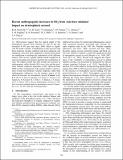| dc.contributor.author | Neely, R. R. | |
| dc.contributor.author | Toon, O. B. | |
| dc.contributor.author | Solomon, Susan | |
| dc.contributor.author | Vernier, J.-P. | |
| dc.contributor.author | Alvarez, C. | |
| dc.contributor.author | English, J. M. | |
| dc.contributor.author | Rosenlof, K. H. | |
| dc.contributor.author | Mills, M. J. | |
| dc.contributor.author | Bardeen, C. G. | |
| dc.contributor.author | Daniel, J. S. | |
| dc.contributor.author | Thayer, J. P. | |
| dc.date.accessioned | 2014-03-20T17:43:08Z | |
| dc.date.available | 2014-03-20T17:43:08Z | |
| dc.date.issued | 2013-03 | |
| dc.date.submitted | 2013-02 | |
| dc.identifier.issn | 00948276 | |
| dc.identifier.uri | http://hdl.handle.net/1721.1/85851 | |
| dc.description.abstract | Observations suggest that the optical depth of the stratospheric aerosol layer between 20 and 30 km has increased 4–10% per year since 2000, which is significant for Earth's climate. Contributions to this increase both from moderate volcanic eruptions and from enhanced coal burning in Asia have been suggested. Current observations are insufficient to attribute the contribution of the different sources. Here we use a global climate model coupled to an aerosol microphysical model to partition the contribution of each. We employ model runs that include the increases in anthropogenic sulfur dioxide (SO[subscript 2] over Asia and the moderate volcanic explosive injections of SO[subscript 2] observed from 2000 to 2010. Comparison of the model results to observations reveals that moderate volcanic eruptions, rather than anthropogenic influences, are the primary source of the observed increases in stratospheric aerosol. | en_US |
| dc.description.sponsorship | United States. National Oceanic and Atmospheric Administration (NOAA/ESRL-CIRES Graduate Fellowship program) | en_US |
| dc.description.sponsorship | United States. National Aeronautics and Space Administration (Land Use and Land Cover Change program ( NASA Award NNX09AK71G) | en_US |
| dc.description.sponsorship | National Science Foundation (U.S.) (NSF grant ATM- 0856007) | en_US |
| dc.description.sponsorship | National Science Foundation (U.S.) (NSF grant AGS-1135446) | en_US |
| dc.description.sponsorship | National Science Foundation (U.S.) (NSF grant ATM-0856007) | en_US |
| dc.description.sponsorship | United States. National Aeronautics and Space Administration (NASA Award NNX09AK71G) | en_US |
| dc.language.iso | en_US | |
| dc.publisher | American Geophysical Union | en_US |
| dc.relation.isversionof | http://dx.doi.org/10.1002/grl.50263 | en_US |
| dc.rights | Article is made available in accordance with the publisher's policy and may be subject to US copyright law. Please refer to the publisher's site for terms of use. | en_US |
| dc.source | Other univ. web domain | en_US |
| dc.title | Recent anthropogenic increases in SO₂ from Asia have minimal impact on stratospheric aerosol | en_US |
| dc.type | Article | en_US |
| dc.identifier.citation | Neely, R. R., O. B. Toon, S. Solomon, J.-P. Vernier, C. Alvarez, J. M. English, K. H. Rosenlof, et al. “ Recent Anthropogenic Increases in SO₂ from Asia Have Minimal Impact on Stratospheric Aerosol .” Geophys. Res. Lett. 40, no. 5 (March 16, 2013): 999–1004. | en_US |
| dc.contributor.department | Massachusetts Institute of Technology. Department of Chemistry | en_US |
| dc.contributor.department | Massachusetts Institute of Technology. Department of Earth, Atmospheric, and Planetary Sciences | en_US |
| dc.contributor.department | Massachusetts Institute of Technology. Program in Atmospheres, Oceans, and Climate | en_US |
| dc.contributor.mitauthor | Solomon, Susan | en_US |
| dc.relation.journal | Geophysical Research Letters | en_US |
| dc.eprint.version | Final published version | en_US |
| dc.type.uri | http://purl.org/eprint/type/JournalArticle | en_US |
| eprint.status | http://purl.org/eprint/status/PeerReviewed | en_US |
| dspace.orderedauthors | Neely, R. R.; Toon, O. B.; Solomon, S.; Vernier, J.-P.; Alvarez, C.; English, J. M.; Rosenlof, K. H.; Mills, M. J.; Bardeen, C. G.; Daniel, J. S.; Thayer, J. P. | en_US |
| dc.identifier.orcid | https://orcid.org/0000-0002-2020-7581 | |
| mit.license | PUBLISHER_POLICY | en_US |
| mit.metadata.status | Complete | |
